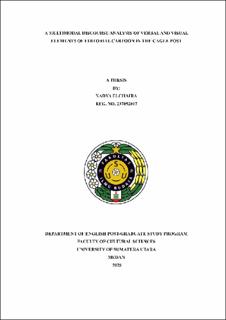| dc.description.abstract | This study investigates the identification, interaction, and coordination of verbal and visual elements in editorial cartoons published on Cagle.com, with the aim of identifying the types of verbal components used, analyzing how they interact with visual features to construct meaning, and explaining why these modes work together in meaning-making. Editorial cartoons are not merely illustrations but complex texts that combine language and imagery to communicate socio-political messages. Using the frameworks of Multimodal Discourse Analysis and Systemic Functional Linguistics, this research qualitatively analyzes 45 editorial cartoons published between January and March 2025. The cartoons were selected purposively based on the presence of both verbal (captions, speech balloons, labels) and visual features (caricature, symbolism, layout, color). The results reveal that meaning is constructed through the consistent and deliberate integration of visual and verbal resources. Caricature (33 cartoons), symbolism (27), and color and salience (30) frequently appear in combination with declarative verbal texts such as labels and captions. These modes co-occur to emphasize political critique and highlight dominant themes such as political manipulation, populism, and economic tension. The study implies that editorial cartoons are powerful multimodal tools for shaping public discourse and understanding political narratives. The findings offer valuable insights for educators, journalists, and researchers in media studies, political communication, and visual rhetoric. It recommended that further research examine audience perception and take into account a greater variety of cultural contexts outside of content that is primarily focused on the United States. | en_US |


